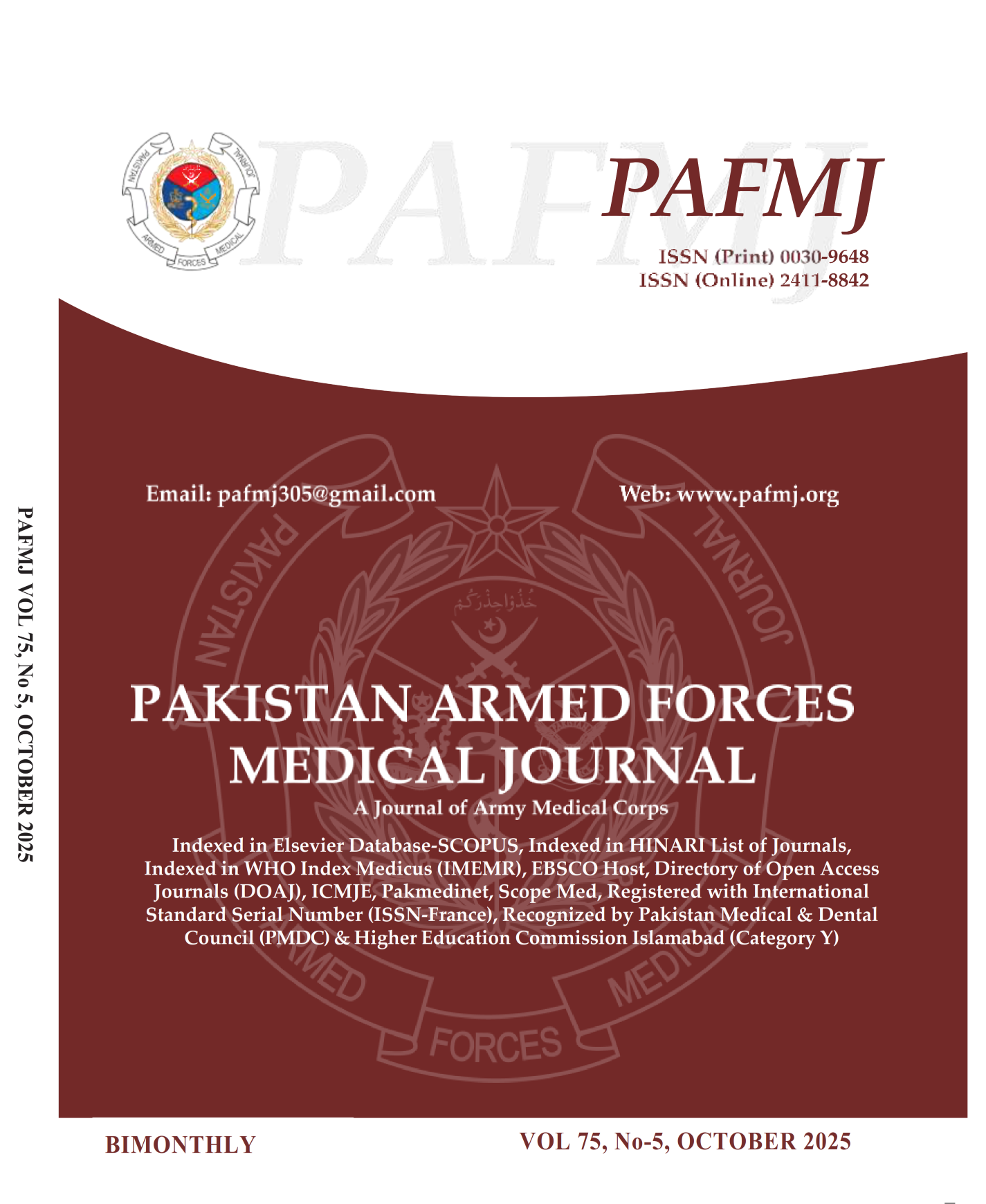Coaptation of Digital Nerves (Centro-Central Neurorrhaphy) at the Time of Terminalization of Amputated Digits Lowers the Occurrence of Digital Neurom
DOI:
https://doi.org/10.51253/pafmj.v75i5.9496Keywords:
Digital amputation, Nerve coaptation, Neuroma. NeurectomyAbstract
Objective: To compare the frequency of occurrence of neuroma in patients with amputated digits who undergo Coaptation of digital nerves versus standard management.
Study Design: Quasi-experimental study.
Place and Duration of Study: Department of Plastic Surgery, Combined Military Hospital, Rawalpindi, Pakistan from Jan 2020 to Sep 2022.
Methodology: The study was conducted on 120 patients with distal digital amputations. Patients with between the ages of 18 and 60 years, of both genders were included. Patients with multiple amputations, previous surgery to the affected digit, complex injuries or proximal trauma to the affected limb, or those with neurological disorders were excluded. All patients underwent microvascular repair of the amputated digit. Patients in the study arm underwent Coaptation of digital nerve while the control arm underwent traction neurectomy. All patients were followed-up for one-year post procedure for the development of neuromas.
Results: Our study sample was composed of 120 patients with a mean age of 35.80±10.29 years, the majority of whom were male: 83(69.2%). Neuroma formation was seen in 5(8.3%) patients who received nerve Coaptation versus 28(46.7%) in those who received a neurectomy, (p<0.001). The median pain score at one-year post-surgery for the sample was significantly lower with coaptation: 2.00(3.00) versus 4.00(3.00) traction neurectomy, (p<0.001). Lastly, significant pain was present in 9(15.0%) who received nerve Coaptation versus 25(41.7%) in the control arm, (p=0.001).
Conclusion: Nerve Coaptation is associated with a significantly decreased frequency of neuroma formation and better pain outcomes in patients with distal digital amputations.
Downloads
References
1 Molina CS, Faulk JB. Lower Extremity Amputation. In: StatPearls Treasure Island (FL): StatPearls Publishing; 2022.
2 Peng P, Guo Q, Tang Y, Huang Y, Luo L, Wei J et al. Replantation of digit-tip amputation caused by crush injuries with supermicrosurgery technique. Eur J Trauma Emerg Surg 2024; 50(4): 1497-1502.
https://doi.org/10.1007/s00068-024-02485-z
3 Kawaiah A, Thakur M, Garg S, Kawasmi SH, Hassan A. Fingertip Injuries and Amputations: A Review of the Literature. Cureus 2020; 12(5): e8291.
https://doi.org/10.7759/cureus.8291
4 Shaterian A, Sayadi LR, Tiourin E, Gardner DJ, Evans GRD, Leis A et al. Predictors of Hand Function Following Digit Replantation: Quantitative Review and Meta-Analysis. Hand 2021; 16(1): 11-17. https://doi.org/10.1177/1558944719834658
5 Erlenwein J, Diers M, Ernst J, Schulz F, Petzke F. Clinical updates on phantom limb pain. Pain Rep 2021; 6(1): e888.
https://doi.org/10.1097/PR9.0000000000000888
6 Modest JM, Raducha JE, Testa EJ, Eberson CP. Management of Post-Amputation Pain. R I Med J 2020; 103(4): 19-22.
7 Shamoun F, Shamoun V, Akhavan A, Tuffaha SH. Target Receptors of Regenerating Nerves: Neuroma Formation and Current Treatment Options. Front Mol Neurosci 2022; 15(1): 859221. https://doi.org/10.3389/fnmol.2022.859221
8 Scott BB, Winograd JM, Redmond RW. Surgical Approaches for Prevention of Neuroma at Time of Peripheral Nerve Injury. Front Surg 2022; 9(1): 819608.
https://doi.org/10.3389/fsurg.2022.819608
9 Kadota H, Ishida K. Coaptation of Cutaneous Nerves for Intractable Stump Pain and Phantom Limb Pain after Upper Limb Amputation. Strategies Trauma Limb Reconstr 2020; 15(1): 50-53. https://doi.org/10.5005/jp-journals-10080-1442
10 Maslow JI, LeMone A, Scarola GT, Loeffler BJ, Gaston RG. Digital Nerve Management and Neuroma Prevention in Hand Amputations. Hand 2022; 8(1): 15589447211065074.
https://doi.org/10.1177/15589447211065074
11 Economides JM, DeFazio MV, Attinger CE, Barbour JR. Prevention of Painful Neuroma and Phantom Limb Pain After Transfemoral Amputations Through Concomitant Nerve Coaptation and Collagen Nerve Wrapping. Neurosurgery 2016; 79(3): 508-513. https://doi.org/10.1227/NEU.0000000000001313
12 Bielewicz J, Daniluk B, Kamieniak P. VAS and NRS, Same or Different? Are Visual Analog Scale Values and Numerical Rating Scale Equally Viable Tools for Assessing Patients after Microdiscectomy? Pain Res Manag 2022; 2022(1): 5337483.
https://doi.org/10.1155/2022/5337483
13 Kawaiah A, Thakur M, Garg S, Kawasmi SH, Hassan A. Fingertip Injuries and Amputations: A Review of the Literature. Cureus 2020; 12(5): e8291. https://doi.org/10.7759/cureus.8291
14 Neumeister MW, Winters JN. Neuroma. Clin Plast Surg 2020; 47(2): 279-283. https://doi.org/10.1016/j.cps.2019.12.008
15 Mehri N, Sadeghi-Bazergani H, Safaiean A. Epidemiological and Clinical Characteristics of Traumatic Hand and Finger Amputations in North Western Iran; A Single Center Experience. Bull Emerg Trauma 2017; 5(1): 42-46.
16 Larsen MT, Eldridge-Allegra I, Wu J, Jain SA. Patients admitted for treatment of traumatic finger amputations: Characteristics, causes, and prevention. J Clin Orthop Trauma 2019; 10(5): 949-953. https://doi.org/10.1016/j.jcot.2019.01.024
17 Long C, Suarez PA, Hernandez-Boussard T, Curtin C. Disparities in Access to Care Following Traumatic Digit Amputation. Hand 2020; 15(4): 480-487.
https://doi.org/10.1177/1558944718824700
18 Pomares G, Coudane H, Dap F, Dautel G. Epidemiology of traumatic upper limb amputations. Orthop Traumatol Surg Res 2018; 104(2): 273-276.
https://doi.org/10.1016/j.otsr.2017.12.014
19 Samantaray SA, Oommen J, Thamunni CV, Kalathingal K, Koyappathody HM, Shet SM, et al. Fingertip injury epidemiology: an Indian perspective. J Plast Surg Hand Surg 2022; 56(4): 224-228.
https://doi.org/10.1080/2000656X.2021.1962332
20 Fakin RM, Calcagni M, Klein HJ, Giovanoli P. Long-term clinical outcome after epineural coaptation of digital nerves. J Hand Surg Eur Vol 2016; 41(2): 148-154.
https://doi.org/10.1177/1753193415578986
21 Usami S, Inami K, Kawahara S, Hirase Y, Shimizu H, Mori H. Investigation of Predictors of Successful Replantation of Distal Digits at the Nail Bed Level: The Contribution of Digital Nerve Repair to Survival Rate. Plast Reconstr Surg 2022; 149(4): 889-896. https://doi.org/10.1097/PRS.0000000000008908
22 Güntürk ÖB, Kayalar M, Bali U, Özaksar K, Toros T, Gürbüz Y. Clinical outcomes of salvage revision surgery following finger replantation with vascular insufficiency: A retrospective study. Acta Orthop Traumatol Turc 2020; 54(6): 577-582.
https://doi.org/10.5152/j.aott.2020.19016
23 Kaneshiro Y, Hidaka N, Yano K, Sakanaka H, Hyun S, Takamatsu K. Replantation for multiple digit amputations: A retrospective analysis of the clinical results. J Plast Reconstr Aesthet Surg 2020; 73(11): 1995-2000.
Downloads
Published
Issue
Section
License
Copyright (c) 2025 Khurshid Alam, Shahid Hameed, Abdul Qadeer, Khawaja Umer Majeed, Shahid Ahmed, Wajiih Uddin Muhammad Butt

This work is licensed under a Creative Commons Attribution-NonCommercial 4.0 International License.















